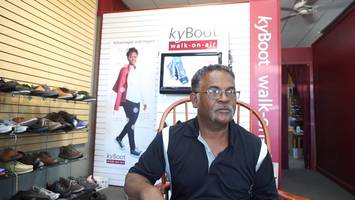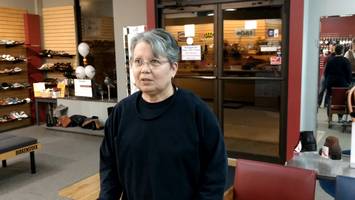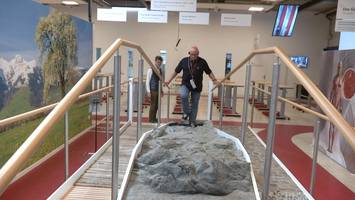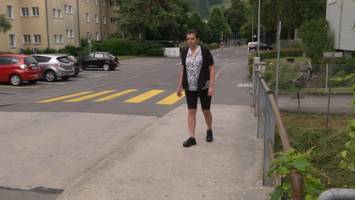Dizziness (vertigo)/disturbance of equilibrium
Those who suffer from dizziness are not alone. More than one out of ten patients complain about dizziness to their family doctor. Dizziness also occurs frequently in young people. Equilibrium disturbances increase significantly with age.
Dizziness is highly varied and there are different forms (e.g. rotary vertigo). Finding the cause is usually difficult, which is why treatment is often non-specific and protracted.
In the kybun shoe/on the kybun mat, you stand on a soft material which allows you to gently train your equilibrium to actively counteract dizziness. It has been proven that exposing yourself to dizziness is the most effective therapy against it.
Definition
Causes
Dizziness may have many causes. Some of them are:
- Disturbances of the inner ear (vestibular system)
- Disturbances in the brain (centre of equilibrium)
- Age (vestibular system in the inner ear becomes immobile)
- Underlying neurological disorder
- Nerve inflammation
- Vascular problems
- Cardiovascular disturbances
- Metabolic disturbances
- Psychological conditions
The wide range of possible causes for dizziness shows just how much the functioning of our equilibrium depends on the health of other body systems.
Long-term consequences
Conventional therapy
The treatment depends on the clinical symptoms.
- As a rule, accompanying balance training is essential, since it strengthens the equilibrium system in general, supports the necessary healing processes and promotes any compensation that may be needed.
- Antibiotics may be used in case of inflammation. Medications to promote circulation or cortisone may be indicated as well. Medications against dizziness known as antivertiginous drugs can help in case of severe vertigo.
- Doctors usually treat benign positional vertigo successfully with targeted exercises or select positioning manoeuvres.
- Tumours or vascular problems may require an operation.
The kybun principle of operation – being proactive
Older people with balance problems often walk much more confidently in the kybun shoe than in normal shoes that support the foot. This seems surprising at first, since orthopaedists or shoe specialists usually recommend sturdy shoes for people with equilibrium disturbances.
http://www.kybun.ch/videos/seniorentraining.html
In the kybun shoe/on the kybun mat, you can move your feet freely. This means all the joints in the foot are used, the foot can adapt to the ground and react to unevenness with compensating movements.
Through the soft kybun shoe sole/kybun mat, you can also feel the ground (e.g. individual cobblestones). This stimulates foot sensitivity, the wearer becomes more confident while walking and the risk of falling is reduced.
Muscle training in the kybun shoe (deep sensorimotor musculature) strengthens and straightens the entire body. Dizziness is reduced and you feel more confident while walking again.
Initial reactions
Specific initial reactions with existing dizziness:
Dizziness may increase somewhat at first since the body is not yet accustomed to the soft, elastic kybun shoe sole. Try to keep your gaze forward and keep walking short distances in the kybun shoe. The body will get used to the increased movement in the kybun shoe after just a few hours and dizziness will be alleviated.
Click here for the general initial reactions experienced by kybun mat and kybun shoe beginners: Initial reactions
kybun exercises
Application tips
- Be sure to maintain an upright body posture.
- Keep your gaze forward and do not look at the floor.
- Do not make your steps too long.
- Make sure your shoulders are relaxed (do not draw them up) and avoid tensing up your feet (do not clench your toes).
- Breathe evenly (many people automatically hold their breath while walking in the kybun shoe because they feel uncertain).
- Take a short kybun break if dizziness gets worse or you no longer feel well.
- The kybun exercises help you to avoid cramping up and assist you with variable balance training.
- Individually adapt the intensity of the kybun training. Try to train in the kybun shoe/on the kybun mat as long and as often as possible. You should, however, always feel well while doing so.
- Try various kybun shoe models. Some models with a higher cut provide more stability. In case of dizziness, we also recommend a kybun shoe model with a lower rebound effect. It is a bit wider in the midfoot area, therefore making you feel more stable while walking (ask for advice in a specialised kybun shop).
- If you still feel too unsafe walking in the kybun shoe, we advise using the kybun mat. The kybun mat is available in three different thicknesses. This allows you to choose the thickness that is most comfortable for you (the thicker, the less stable, and the more intensive the training).
You can also hold on to a fixed object if you need additional support when using the kybun mat.
Opinions/customer testimonials
I would highly recommend wearing kybun shoes during pregnancy. For me, it was the perfect shoe to wear during the day to relieve the increased pressure on my feet and other joints and gently strengthen my body at the same time. I often felt physically tired, but my kybun shoes motivated me to keep moving and remain active during my entire pregnancy. Walking is so comfortable that even on days when you’re tired, you still feel like walking for a few kilometres. And you feel very fit afterwards. Another thing I love about kybun shoes is how they activated circulation in my legs. I suffered from circulatory problems and would often suddenly feel a strong, shooting dizziness sensation, particularly in the mornings. That’s why I was so happy to find a shoe that activated my circulation! Wearing the shows, together with surgical stockings, really made me feel a lot better. I never had the back pain that many pregnant women suffer from. I don’t know if I was just lucky or if it was thanks to my daily exercise in my kybun shoes. I’m pregnant now for the second time and enjoying walking in my kybun shoe to relieve the strain on my body and exercise at the same time.
To me, it was like walking on clouds. Nice and soft. But after about a quarter of an hour I started to feel quite dizzy. At first I just did a little exercise at a time. So that it wouldn't be too much for me at first, as it was a challenge in terms of balance, too.
"The kybun shoe means you can walk actively and healthily even on hard surfaces. The soft, unstable sole is kind on your joints, exercises your muscles, improves your balance and stimulates receptors in your feet. From a medical perspective I thus specially recommend the kybun shoe to patients with poor posture or knee problems."
"kyBoot help you keep balance and activate your muscles, from your toes to your back: they are helpful in the treatment of pain in the heels and forefeet, and are a method of choice to support the treatment of pain in the Achilles tendon and back."
I gained greater strength in my back and in that whole area. And I think it also actually improved my balance, my feeling of being able to keep my balance better. ![]() Watch the video
Watch the video
As an epilepsy sufferer, I was always very mindful when going for walks, shopping or on the way to work. This was because when I was out walking, and often without notice, I had to deal with restricted movement and very severe coordination problems. Although at first I could scarcely believe it: From the moment I first put on my kybun Sorak Black shoe, I was a different person. My perceptions when walking are completely different than before. It's also great to have a colleague at work with similar symptoms, who I can now help with their walking.










![[Translate to English:] Jens Müller](/fileadmin/_processed_/c/3/csm_JensMueller_01_3c94f6e71b.jpg)




